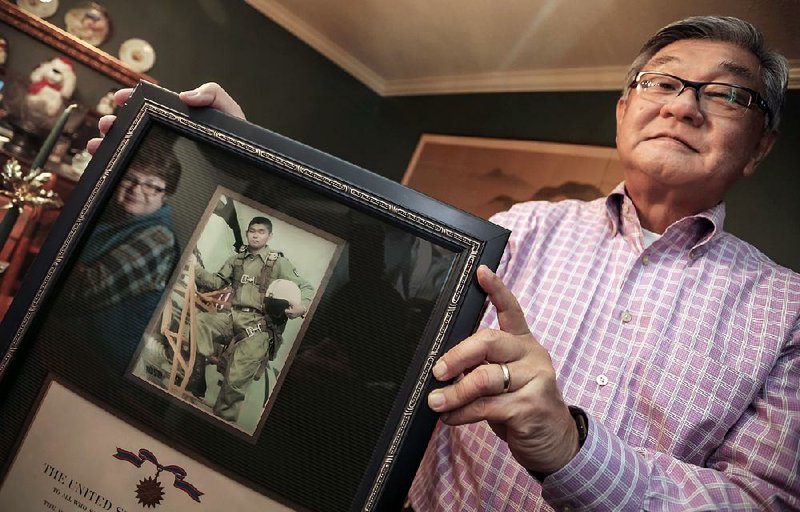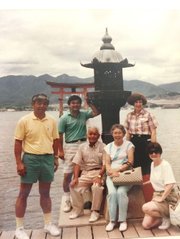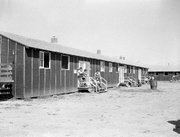This is the second piece of a two-part series. Part one appeared Sunday. See arkansasonline.com/internment.
Until he learned that his cousins had died when an atomic bomb demolished Hiroshima in 1945, Richard Yada didn't think twice about joining the U.S. military.
He and his older brother, Bob, both served during the Vietnam War, despite spending the early years of their childhood imprisoned at Rohwer War Relocation Center in Arkansas.
More than 120,000 Japanese Americans were taken from their homes and sequestered during World War II in 10 camps across the country, including two in the Arkansas Delta.
His was the only Japanese-American family to settle in the Natural State after being kept behind gates for years. A few other families chose to stay awhile and took up sharecropping along with the Yadas; none of them remained long-term.
In the years that followed imprisonment, Japanese-American families fought to recover. They had lost their homes, businesses and many belongings. Families were no longer tightly knit. Their place in society going forward was unsure.
'DEATH FELL FROM THE SKY'
"To undo a mistake is always harder than not to create one originally, but we seldom have the foresight."
-- Eleanor Roosevelt
Richard and Bob's mother, Haruye Masada-Yada, who died in 2014, was born in the United States but spent part of her childhood in Japan. And when she was a teenager, her father moved the whole family back to Japan for a year while he underwent treatment for what they thought was stomach cancer.
His decision to return to the United States, although it upset extended family who wanted his support, probably saved Haruye's life. In a 2003 interview she gave to the Japanese American National Museum, she remembered how she got married in California and so didn't return to Japan when her parents went back again.
Although she wasn't free during the war, being interned at Rohwer, she also was not with her cousins when "Little Boy" exploded over Hiroshima.
The morning of Aug. 6, 1945, a warning came through the city that there would be an air raid -- maybe about three small planes would drop a few bombs. Haruye's cousins loaded up on buses to drive away from the danger zone.
What came instead was an atomic bomb, a mushroom of smoke billowing in the sky. The first sitting president to visit Hiroshima, Barack Obama, in 2016 called it the day "death fell from the sky and the world was changed."
Haruye's cousins and uncle were killed, she said in the interview.
One teenage cousin's body was found. The details of its condition from family members who tried to pick it up out of rubble haunt Richard.
But her parents were safe. Their savior was a hill near their house. Haruye told interviewers that the "shadow of the mountain" protected them from the blast.
"The justice those days was interesting," Haruye said. "The idea of dropping the atom bomb on Japan."
The second bomb, dropped five days later on Nagasaki, brought the estimated death toll up from about 150,000 to 225,000. These estimates are conservative; bodies and documents were unrecognizable, according to a report from the University of California at Los Angeles.
At the time of the bombings, a dozen American prisoners of war were being held in Hiroshima. They also died.
Before the bombings, more than 4,000 Japanese Americans had been released from internment in the United States to join the 442nd Regimental Combat Team, a collection of Japanese-American soldiers led by Caucasian officers.
This team, which fought in Europe, became the most decorated unit in U.S. military history for its size and length of service -- with more than 18,000 awards. It also had an uncommonly high casualty rate, formally reported as 93 percent. Troops had to be replaced nearly 2.5 times, according to information from the Densho Encyclopedia, which chronicles the stories of Japanese Americans during WWII.
SHARECROPPING
"If I cannot be nominated by the white voters of Arkansas, I do not want the office."
-- Arkansas Gov. Homer Adkins after an endorsement by a black Democrat
When the camps closed, former internees were not allowed to own land in Arkansas. The governor at the time, Homer Adkins, backed the law that kept anyone of Japanese descent from owning land. Adkins was a known member of the Ku Klux Klan, although he later said he only joined to gain political support.
"He [Adkins] said you can build those camps here, but once the war is over these people have got to leave," Richard Yada said. "They cannot go to school here. They cannot buy land here. They've just got to leave. Most of them did."
Several families, including the Yadas, took up sharecropping so they could get around the law and stay in Arkansas.
Sam Yada, Richard and Bob's father, had heard from friends back in California that life as an Asian-American was bleak in the West; property had been stolen, homes were being shot at and racism was rampant. He decided to keep his family in Arkansas.
They started sharecropping in Scott in 1945, along with several other families who had left Rohwer. Sam drove a truck for the group so his family could make a little bit of extra money.
"They shared the tractors: 'It's your turn to use the tractor, my turn to use the mule,'" Richard said. "They brought all the produce in together."
From their one, 15-by-20-foot room in the camp, the family had upgraded to a house with three rooms and running water for a bathtub. The wooden floor had holes in it, and the chickens would run underneath. Richard entertained himself by finding pieces of corn or small sticks to drop through the holes onto the chickens' heads.
"It was not very well built," he said. "The wallpaper was old newspapers, so when the wind blew you could see it go in and out."
Bob was old enough to drive, so he helped out on the farm. He remembers it as the hardest work he has ever done.
Both boys were going to school, and Virginia Alexander, the woman who owned the land the Japanese-American families were farming, fought for them to go to the white school.
"That was a life-changing event for me because the black schools weren't getting any funding for their education," Richard said. "All the white schools were getting all the money for education and the black schools weren't getting their equal share of education money, so [switching schools] made a big difference for me."
Bob graduated from Little Rock Central High School in 1955, just two years before the school desegregated. It was close to the same time when the family moved onto their own farm, near North Little Rock. They began their greenhouse business there, planting tomatoes.
After two decades of building that business up, Sam and Haruye had to move again when Interstate 440 was being built and scheduled to go right through their living room.
LIFE MARCHES ON
"They demonstrated conclusively the loyalty and valor of our American citizens of Japanese ancestry in combat."
-- Gen. Mark W. Clark, WWII officer
The other families who started sharecropping with the Yadas moved off one by one, putting distance between themselves and the place they had been prisoners, until only the Yada family was left.
Bob was going to junior college and stayed home to help out with the greenhouses. He started at the University of Arkansas, Fayetteville, but didn't finish because he joined the Army. He was a part of a medical team that got called up during the Berlin Crisis in 1961. He finished school later, after the crisis, and worked for the Army at Fort Chaffee for most of his career.
He also got a call in 1975 when Vietnamese refugees came to Fort Smith after the fall of Saigon.
"I was in bed," Bob said in an interview with a representative from The Fort Smith Historical Society. "And early in the morning, I got a call from my boss."
He and his crew worked to get the fort ready for buses full of Vietnamese people to arrive; he said they were treated better than he and his family had been in the refugee camps.
"Until I started talking to some people in surrounding communities around Rohwer, they thought we were getting treated pretty good ..." he said, explaining that the outside world thought the Japanese Americans in camps were getting better food than everyone else. "After that, I kept my mouth shut."
Both Yada brothers were in the military during the Vietnam War; Richard was deployed after completing an Army Reserve Officers' Training Corps program at UA.
"Things started heating up, so by the time I graduated in '65, it was full-blown," Richard said. "So I said, 'I'll go in as an officer and get it over with.'"
Richard flew combat missions for the U.S. Air Force in Guam, Thailand and Okinawa, Japan.
His wife, Barbara Yada, had all three of their children while he was on active duty.
"I was just barely pregnant when he left, and then he was gone six months and I was pretty far along," she said of their second child.
At the time, Richard said, he had no qualms about joining up; it was just what everyone was supposed to do. But he did have qualms later when he found out about his family members who had died at Hiroshima.
"So they killed my cousin and tried to kill my grandparents, I guess, and then a few years later, I'm wearing the same uniform," he said.
MAKING AMENDS
"In retrospect, we understand that the nation's actions were rooted deeply in racial prejudice, wartime hysteria, and a lack of political leadership."
-- President Bill Clinton
When Richard and Barbara were putting their kids through college, the apology letters came from President Bill Clinton to all the Japanese Americans who had been imprisoned. Each letter included a check for $20,000, and "a sincere apology."
"It was short and sweet, I guess," Bob said. He bought stocks with his money, but ended up taking a loss on the investment.
Barbara said she and Richard used the money to help pay for their children's tuition.
Sam, who kept the greenhouse after his sons had moved out, started efforts to preserve the memory of what happened in Rohwer, beginning with conserving the memorials internees had built.
"They're still there," Richard said. "They were made by the people in the camp. They only had scrap material to build them."
Sam started pushing in the 1980s to get a more permanent memorial there, according to fundraising letters he sent out. These efforts were realized in 1982 when a monument was erected describing what happened. An American flag flies next to the stone marker.
The memorial is in front of a cemetery of about 25 graves of those who died while imprisoned at Rohwer.
"He [Sam] said one of these days these things are going to fall and nobody is going to care," Richard said. "So he raised money and built a granite monument there behind the two that are there. He said if the others fall, at least this one will be here so people will remember what this was about."
The monument is about eight miles from the World War II Japanese American Internment Museum in McGehee, which opened in 2013.
Most of the museum's visitors have used the spot as a pit stop on the way to another location, museum curator Susan Gallion said.
Introducing visitors to the museum, Gallion criticizes the government's actions in establishing the camps, and chuckles at herself when she does.
Although she has lived in the Delta for years, she didn't know about the internment sites until she started working for the museum at its opening.
The museum includes art made by internees, personal accounts and photos. Actor George Takei, who was interned at Rohwer, is scheduled to attend the fifth anniversary of its opening this year, Gallion said. Takei played Hikaru Sulu on Star Trek.
Another monument to help people remember what happened is in the works at the site of the Honouliuli Internment Camp, near Waipahu, Hawaii, according to the National Parks Service website. The camp there held about 4,000 people.
The Butler Center for Arkansas Studies has embarked on a two-year journey that describes what happened in Rohwer and Jerome through art and artifacts. Richard attended the opening of the most recent exhibit, the third in the series, Jan. 12.
The exhibit, "Education in Exile: Student Experience at Rohwer Relocation Center," will hang in Concordia Hall until June 30 when room will be cleared for the fourth and final piece of the series.
RELATED ARTICLE
http://www.arkansas…">Exhibits explore internment
ActiveStyle on 01/29/2018


